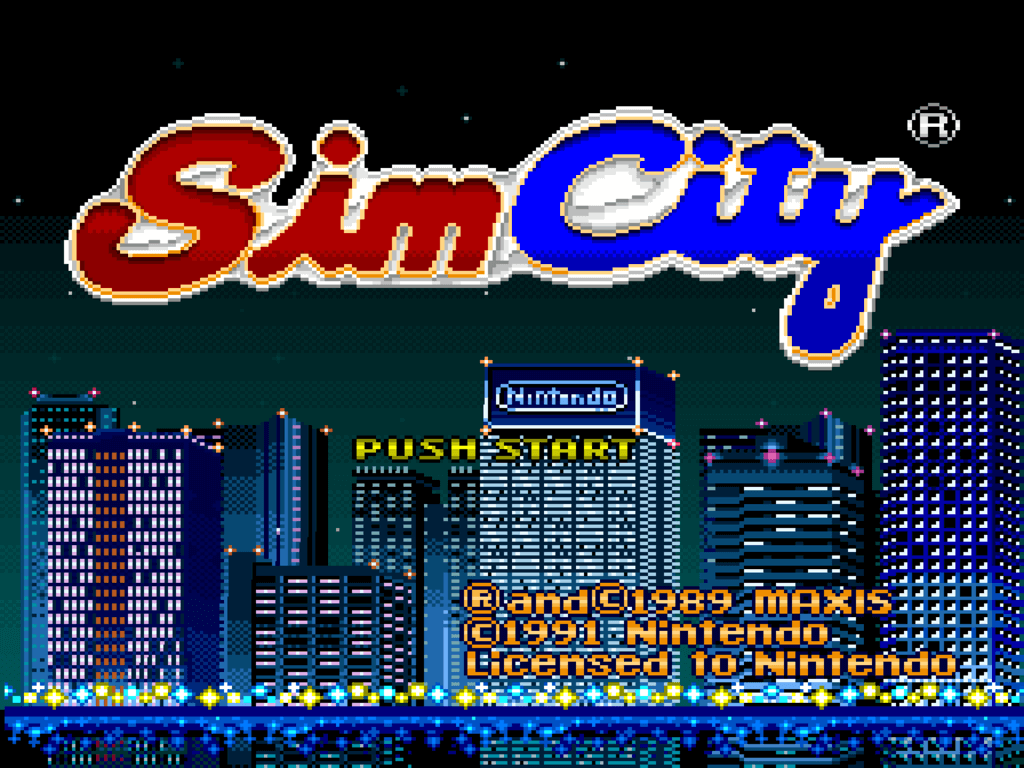
Since I was young child I have been playing the Super Nintendo SimCity off & on, e’ery time trying to reach 500,000 population & reaching the coveted “Megatropolis” city level, & then 600,000 to get the coveted Mario statue building gift, & e’ery time filling up my city long before being able to e’en get close to 500,000.
That is until recently.
SimCity PC vs. SNES
SimCity is 1 o’ the few sim games where the console version is unquestionably superior to the original — to the point that I only e’er played the PC version once &, ’pon quickly filling up the city, feeling no need to e’er go back. Being developed by Nintendo themselves in their prime probably helped. Making a mo’ conscious comparison now, it seems the only major difference ’tween the main simulations were the addition o’ music, better visuals, & gift buildings to the SNES version, but these improvements — especially the gifts — did a lot to make the game feel less static & added just that right amount o’ diversion from just constantly plopping down residential, industrial, & commercial zone blocks & rails to keep the game from getting too boring after a while. It seems I am not alone in this belief, as when I looked up guides on the original to compare what I couldn’t find on my own — such as whether or not the original had hightops, which I couldn’t get to show up in the PC version, e’en in the areas with high land value — all I found were SNES guides.
Gifts were special buildings you would earn for accomplishing certain goals, including large parks or train stations for building a lot o’ parks or train tracks, a fountain for passing 50 years, & the choice o’ either an amusement park or casino for getting ’nough schools or hospitals or building ’nough roads. The main effect o’ most o’ these is to massively increase land value o’ surrounding buildings, which is key to developing areas & getting large populations, & in many cases getting extra yearly income, which is useful, as if you play this game the expected way money can be tight.
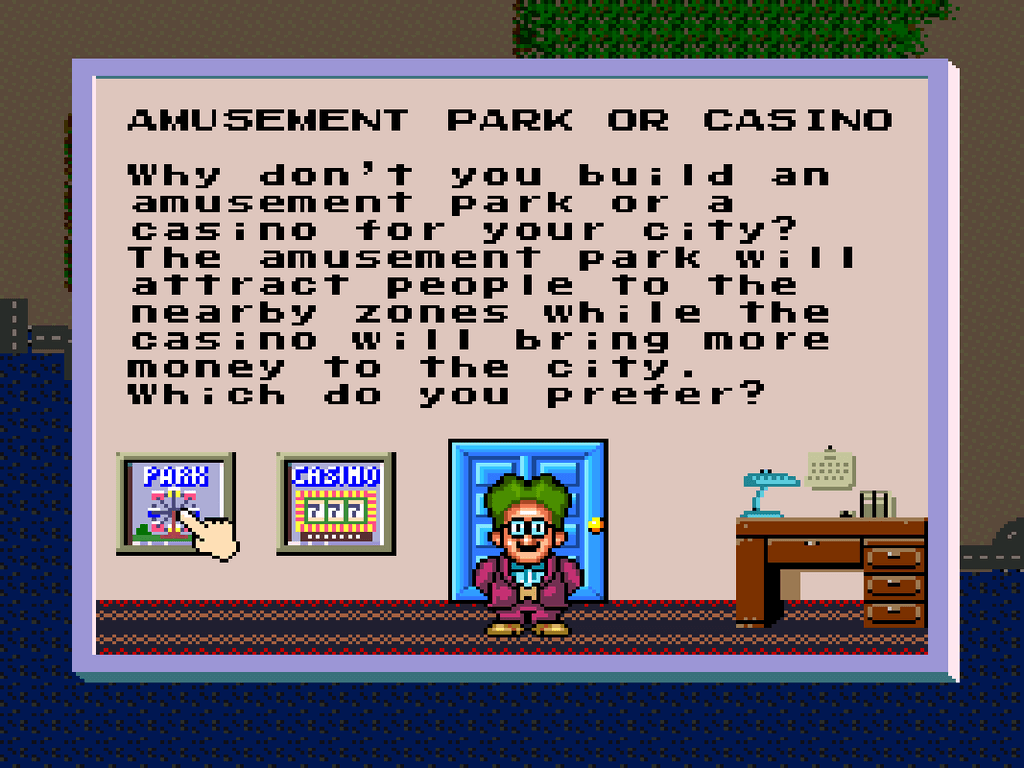
Finally getting Megatropolis
¿So how did I figure out how to finally beat this game? I came to the realization that playing this game the way the game tells you to play is a bad idea & that the best way to play this game is to look up strategies by people who have accomplished record-high-population cities & have thru that analyzed how the game actually works to find the best exploits — ’cause like e’ery SimCity game, I’ve come to discover, this game has many glitches & weird hidden mechanics. Luckily, it just so happens that somebody made a YouTube series earlier this decade describing many tricks & mechanics allowing them to reach mo’ than 900,000 population, which I have used to some extent myself to reach 600,000.
Now, I was doing this on Retroachievements, so I couldn’t use save states, which is to be expected, since that’s cheating. Unfortunately, 1 major glitch that has been known ’bout long before this YouTube series came out is that when you load a save, the city starts out without any power for a few seconds, wrecking land value in the city for a while; & e’en if I kept the game running for the duration o’ building a city, there’s no way to turn off disasters, & e’en on easy plane crashes happen constantly once you build the necessary airport, & if a plane crashes on a scarce gift building, that will screw up that area’s demand, requiring a reload. & as it turns out, 1 major quirk o’ the game is the way commercial development works: they develop based on local land value, like residential areas, but will not lose development if nearby land value drops from, say, industrial developing nearby or the center o’ the city shifting unless the zone loses power. What this means is that optimizing the way the video series recommends is impossible, which is why the introductory video outright says you need to use save states. Fortunately, I only needed 600,000, not 900,000, which is ’nough when playing suboptimally ( I can’t imagine hardly anyone could’ve beaten the game before recently if you needed to do all this optimization just to beat it ), & in any case, playing optimally is unbearably tedious: you have to mainly focus on building commercial buildings, block by block, while building a bunch o’ junk residential areas in other places to keep commercial demand high & maintain the city center where you’re building commercial.
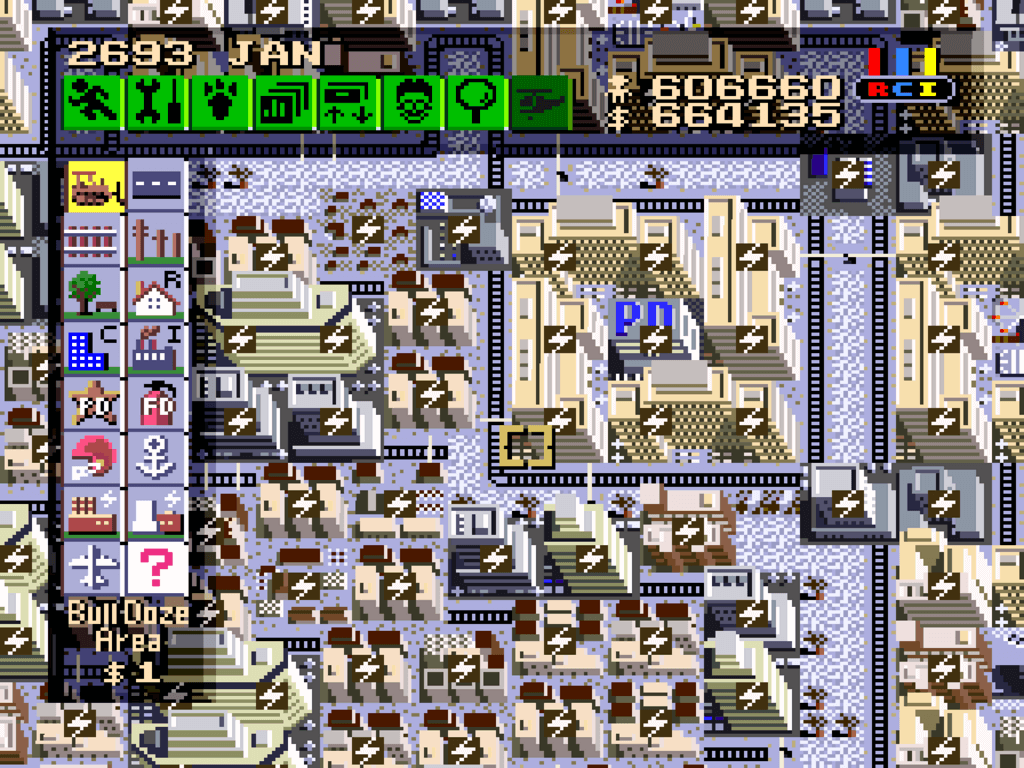
I should also note that Retroachievements had an achievement for getting Megatropolis without using the long-well-known cheat to get $999,999, which the video series also recommends, but admits is only for convenience sake. I’m fine with this, as I think using a money cheat just to beat the game is lame, & there is a simple trick to make lots o’ money e’ery year: defund the police. This video series reveals that the only impact crime has on a city is decreasing local land value; if you can get local land value high ’nough thru other means, such as thru gifts or being in the city center, police are not necessary for getting high-developed zones, & thus are not necessary @ all. This is good, as police are the most expensive services to maintain in this game. Avoiding the police allowed me to play the game with 1% taxes & still make thousands o’ $ e’ery year, to the point that on easy mode I accidentally screwed myself out o’ the no-money-cheat achievement by naturally making maximal money, making the system think I cheated. When I replayed on hard for another achievement, I had to keep an eye on my money & deliberately throw ’way money on airports to keep from triggering the cheat detection.
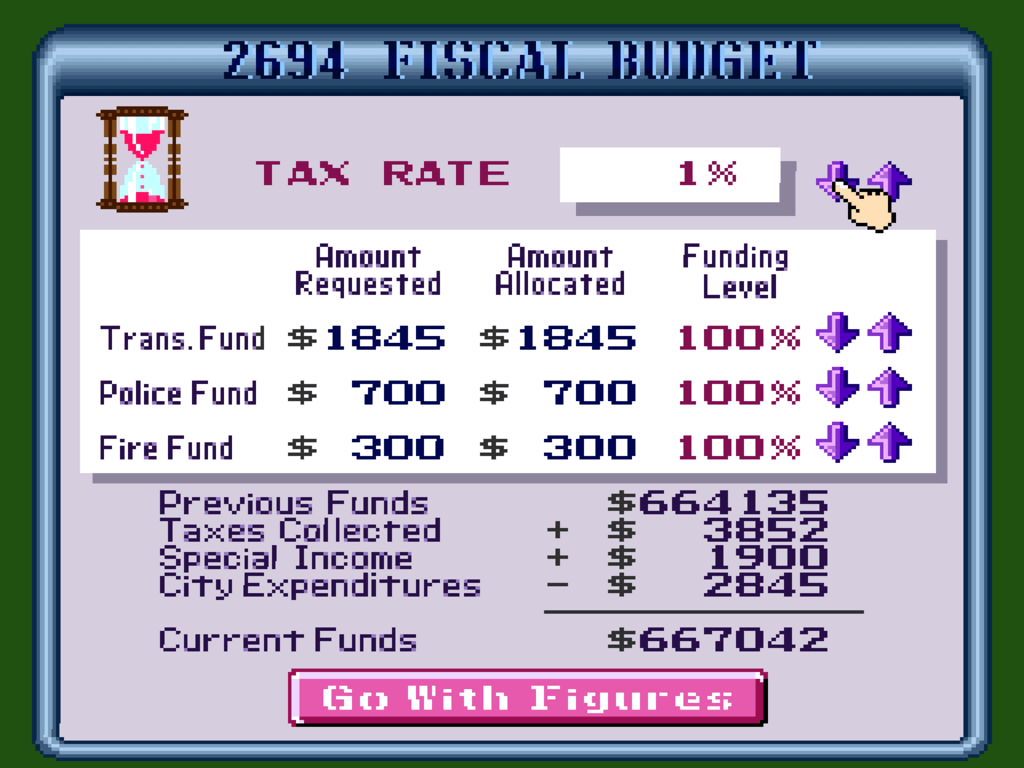
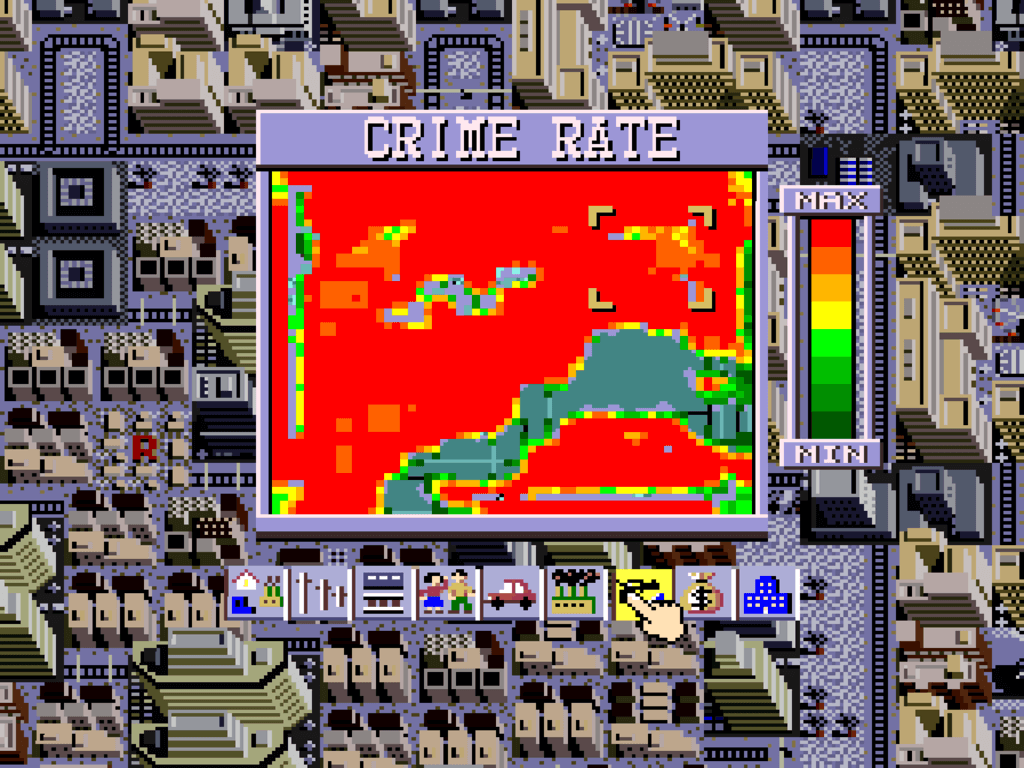
So I followed a much simpler version o’ the strategy the video series recommends: building a ring o’ donuts o’ residential zones with 1 block o’ space between them 2 zone blocks from the edges with gifts inside them to maximize land value & commercial round the corners & sides & industrial on the far edges, & then packed residential & commercial zones in the center in a weird diagonal pattern o’ 2×2 blocks with 2 tiles o’ rail connecting zones’ corners. This takes into account 2 weird mechanics o’ this game: the fact that the city center naturally has high land value & will inevitably stabilize in the center o’ the area as the whole area gets filled in, the fact that residential — & only residential — needs to be connected to some other zone like commercial or industrial in order to develop to its best potential, & the weird way land value is applied to land in hidden 4×4 blocks: land value boosts are applied to any 4×4 blocks in which the block resides, so optimizing the land value o’ gifts means placing them in spots that cover 4 4×4 blocks touching each other’s corners. Placing the 1st donut block 2 zone blocks ( 6 tiles ) off the corner both horizontally & vertically & making the donuts 12 tiles ( an even 4 4×4 blocks ) instead o’ 11 by adding an extra space ’tween their rail rings ensures that each gift will be in 4 4×4 blocks.
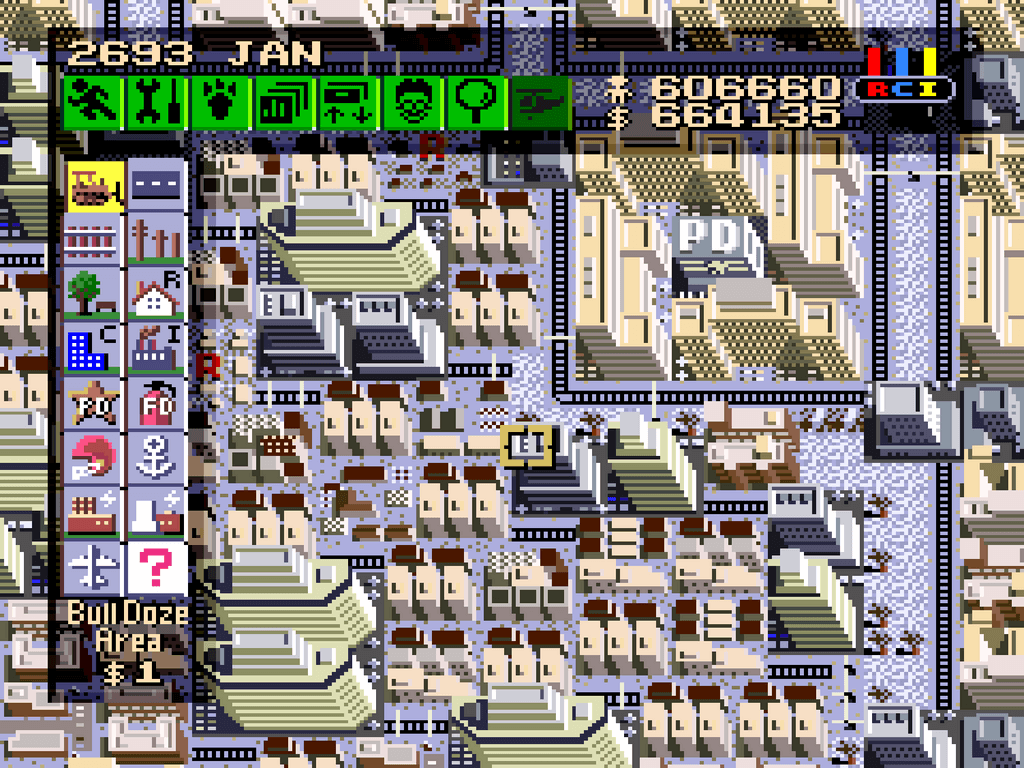
I, ’course, employed other strategies that I knew since I was a li’l kid, such as only using rail, as roads only create traffic, pollution, & crime & cause land value to plummet & thru that cause tax income to decrease, making them inferior to rails in e’ery way, e’en in terms o’ finances, despite rail otherwise costing mo’; using map 61, which has been known for a long time to have the most land o’ all 200 maps; only using nuclear power plants for similar reasons to only using rails; & only giving industrial & commercial 1 tile o’ rail, as that’s all they need & it allows for mo’ space for mo’ zones or land-value-increasing parks.
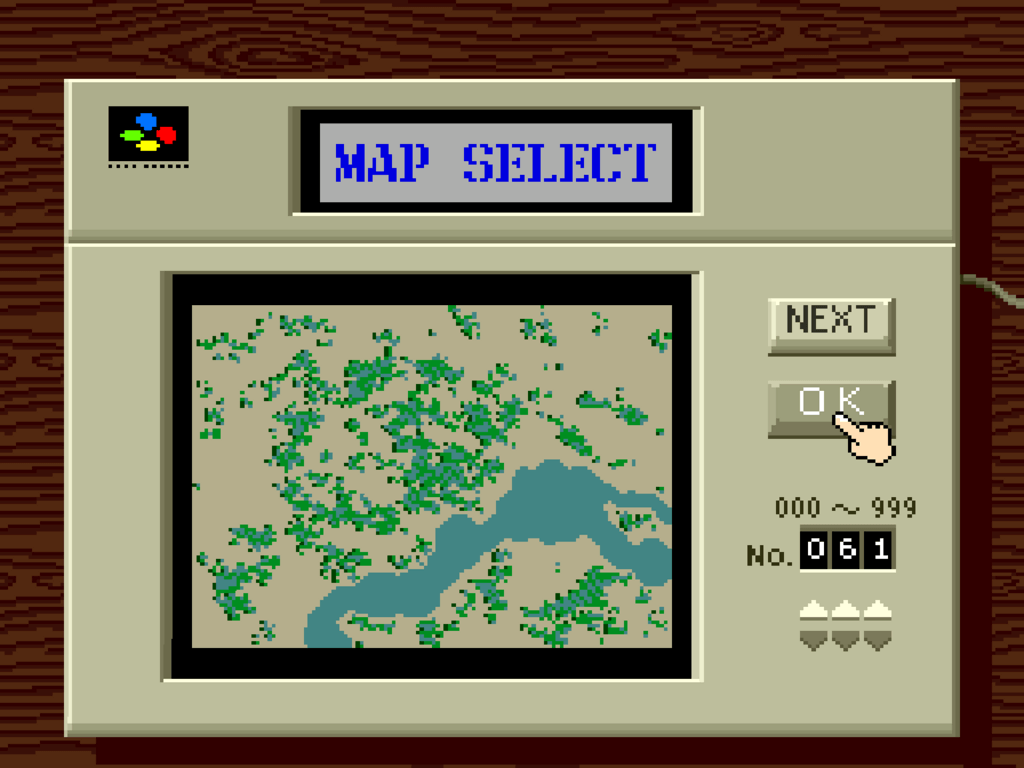
Using these strategies I was pretty easily able to reach megatropolis e’en on hard mode without having to fiddle with specific commercial zones too much.
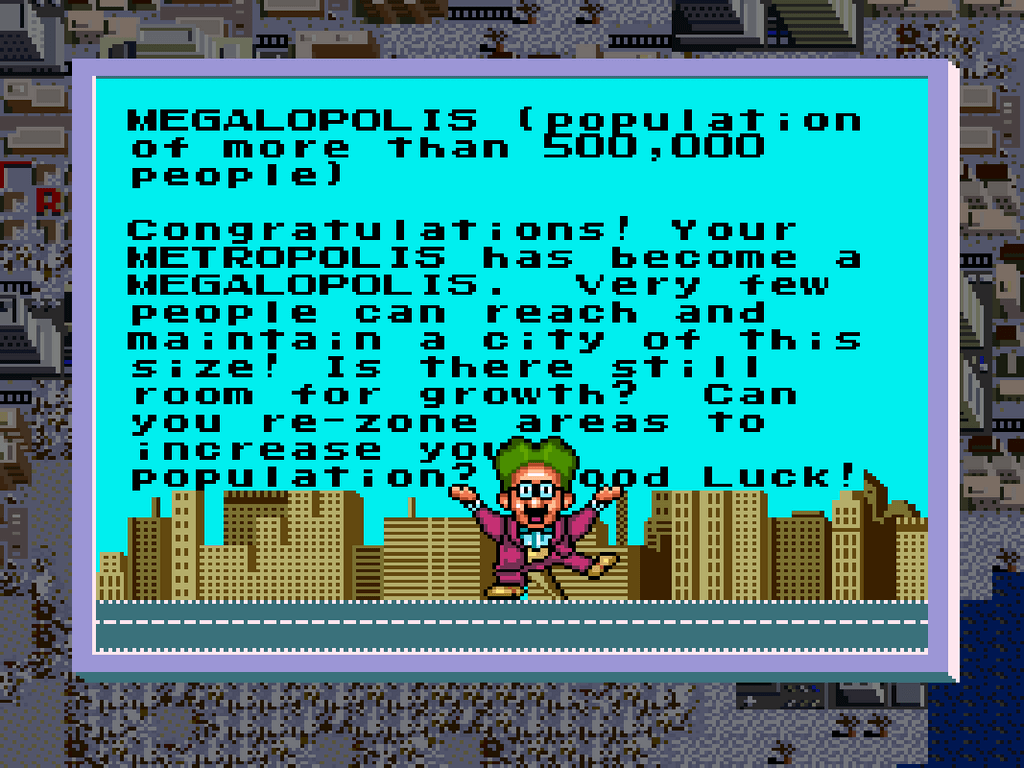
Hard Mode
Speaking o’ which, Retroachievements also had an achievement for getting megatropolis on hard, so I tried that for the 1st time in my life.
It’s well known that hard mode starts you with only $5,000 instead o’ easy’s $20,000, but it has other effects, such as decreasing tax income, increasing yearly expenses, & making disasters other than plane crashes mo’ common. This includes, to my surprise when I 1st saw it happen, nuclear meltdowns if you have a power plant, which I initially thought only happened in the Tokyo scenario. In fact, these meltdowns happen so oft that they make using nuclear power plants infeasible, requiring the use o’ coal power plants for the 1st time, which unfortunately wasted precious land on mo’ power plants.
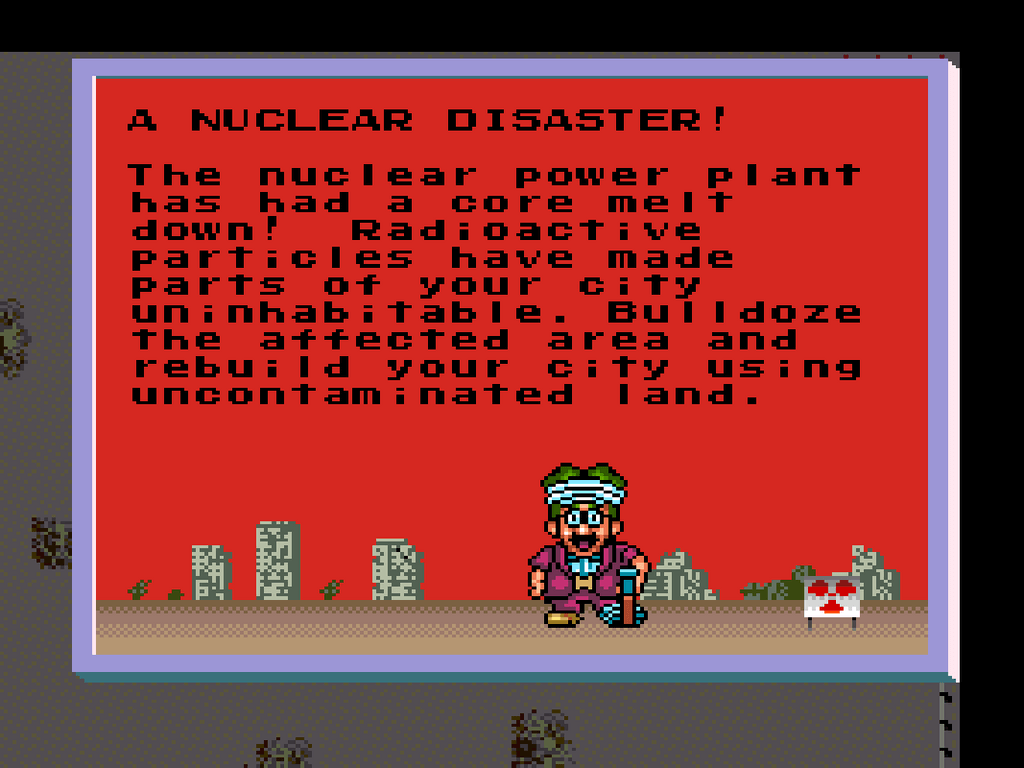
1 funny quirk I also found out is that the only effect o’ nuclear waste is to cause land values to plummet. Since power plants & industrial zones don’t care ’bout land value, you can still develop industrial zones just fine in nuclear waste.
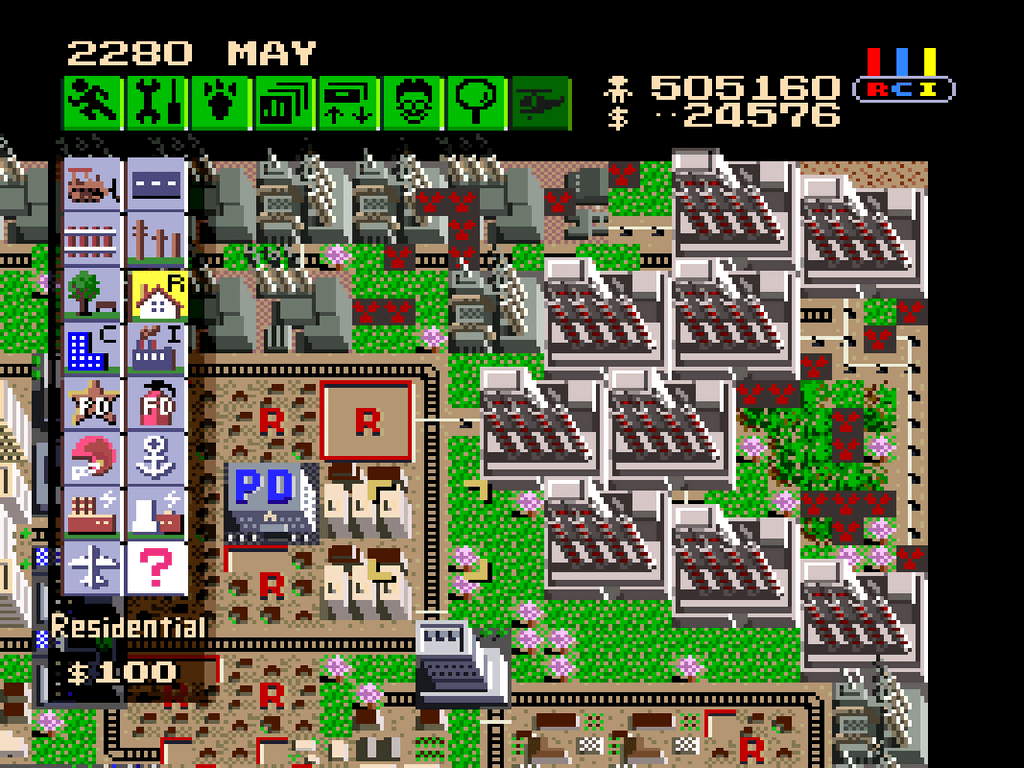
As mentioned earlier, despite these challenges, I was able to build 500,000 population the same way & was still able to make large surpluses o’ money.
Scenarios
Retroachievements also had achievements for completing e’ery scenario, so I did that, too. This was not the 1st time I did these, howe’er: when I was a kid I would have to complete these e’ery time my cartridge’s saves would mysteriously vanish & I would lose access to the “Freeland” scenario.
San Francisco Earthquake
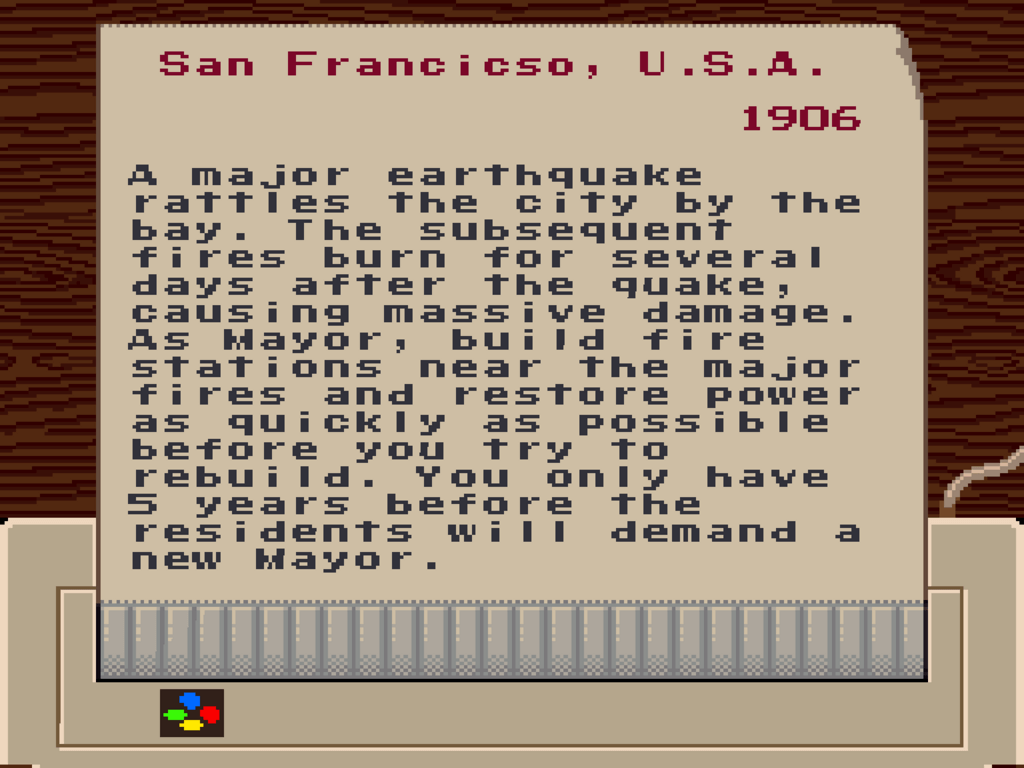
Being the 1st scenario, this is also the simplest: the earthquakes require the least cleanup & then you can just build up the city’s population the same way as in the normal game, building plenty o’ residential & commercial in the center to get high-density places.
Bern Traffic
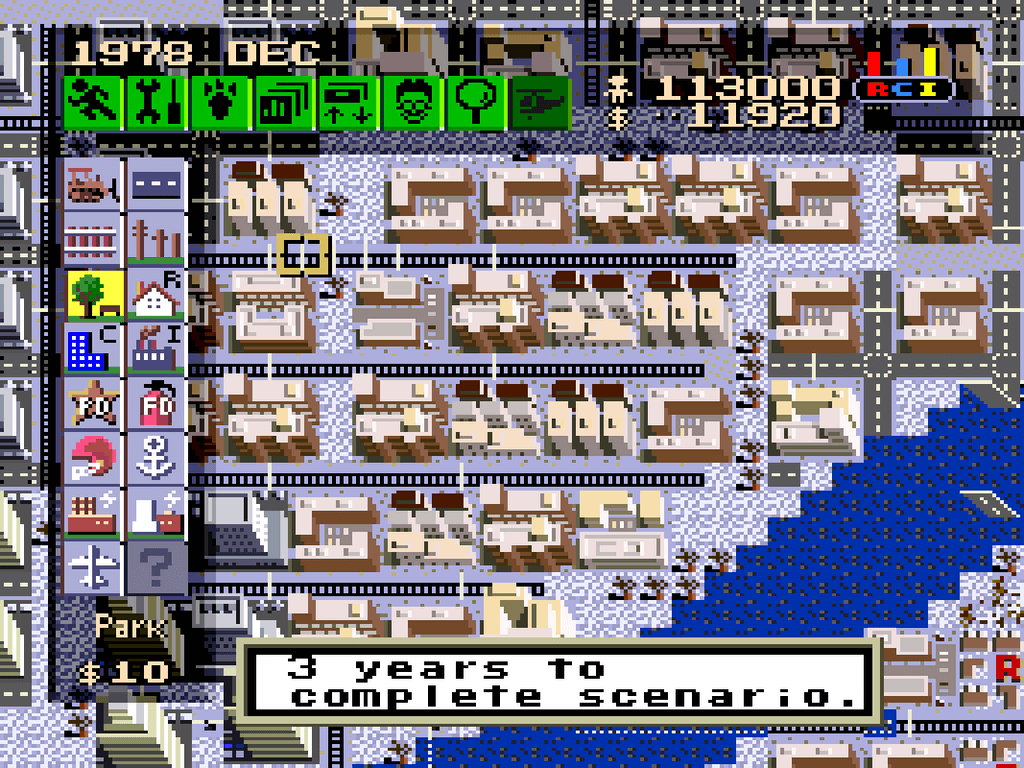
This 1’s very easy, but you do have to make sure to replace road with rail, which improves the city, anyway. I found that out the hard way when I initially tried just developing the city without touching the road much, only to fail, anyway. I don’t know how much you have to replace to win: I just replaced all roads with rail, which you can easily afford to do within 10 years if you budget adequately ( read: defund the fire stations, as they’re expensive & useless ).
Tokyo Monster Attack
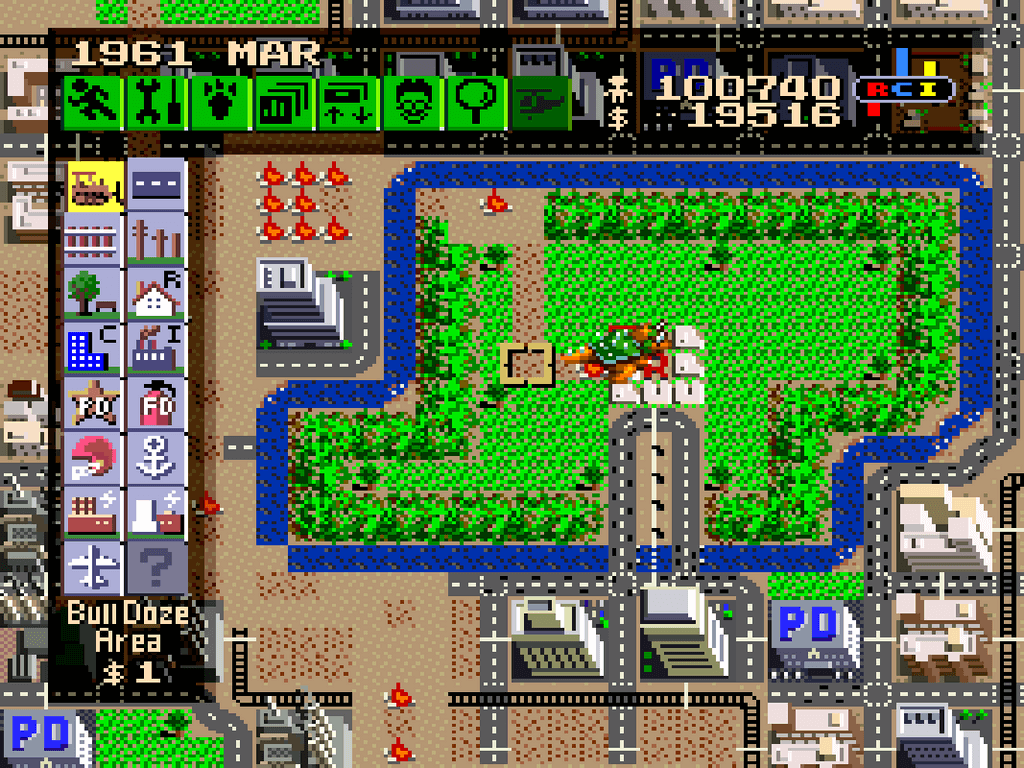
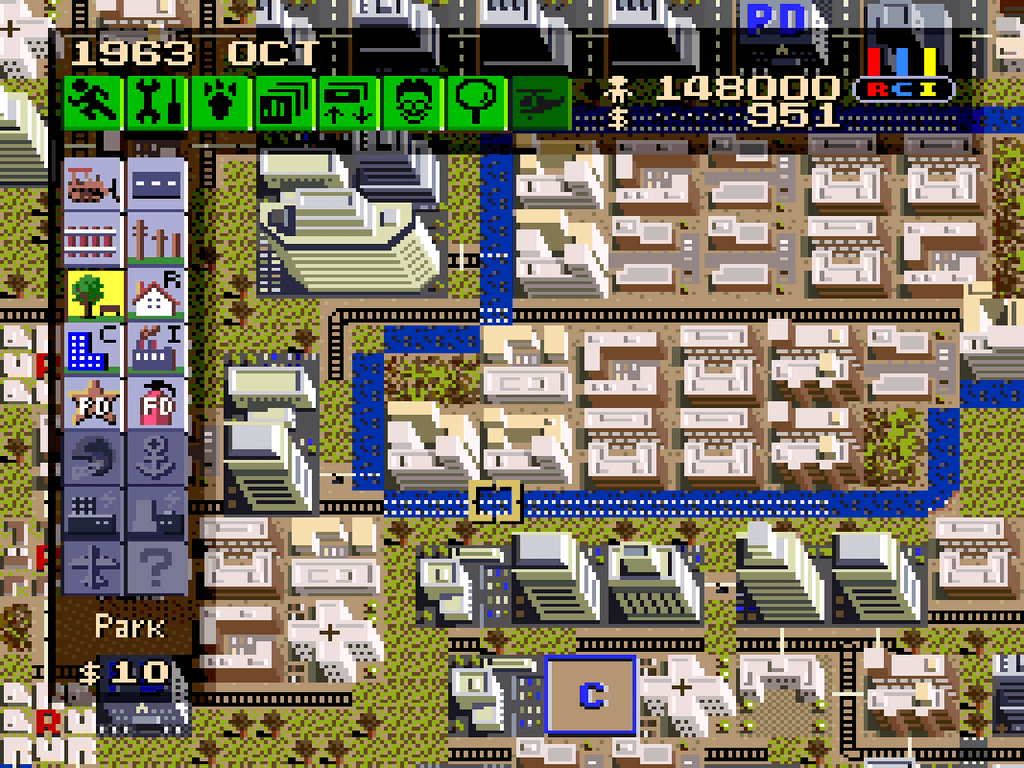
Similar to San Francisco, but Bowser’s attack goes on longer & causes mo’ damage. The garden area o’ the Tokyo Imperial Palace in the center o’ the map provided prime real estate for top residential & commercial after Bowser destroyed said palace ( represented by a single residential block ) & the royal family presumably fled to a safer city.
Detroit Crime
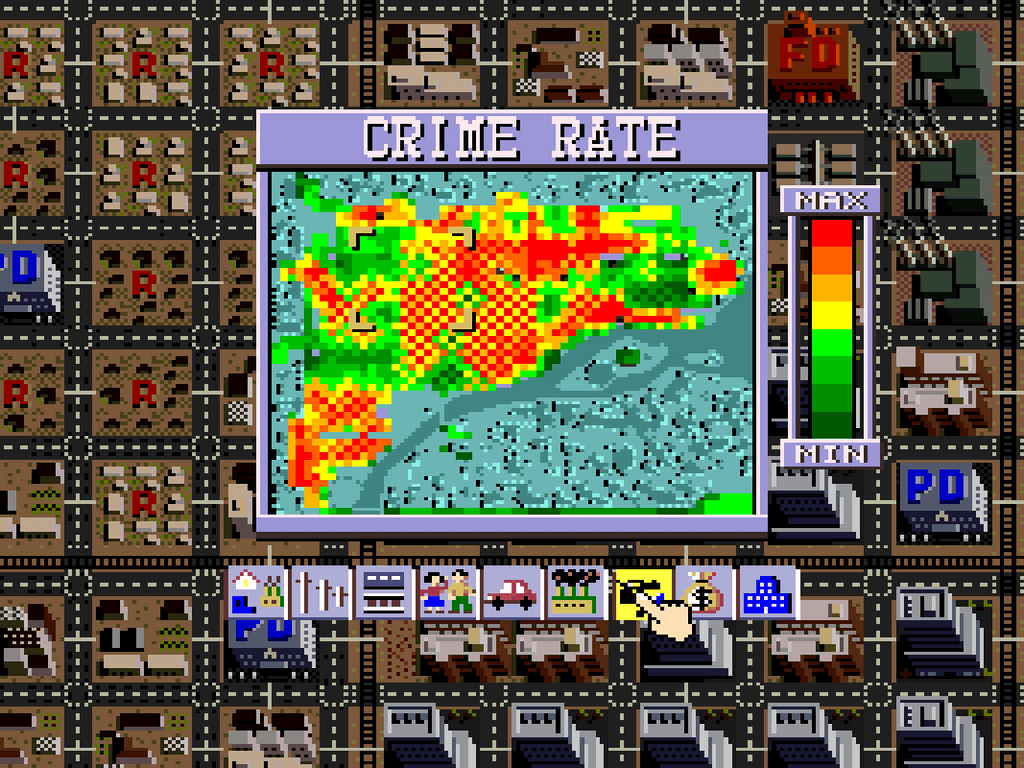
This 1 was surprisingly the hardest ’mong them. For 1, the scenario actually demands you lower crime, rather than just bring up populations, which means you need to spend a lot on police stations, which can make money tight. Unlike many other scenarios, where you can blow all your money @ the end & e’en lower taxes to nothing, since the police no longer function when you’re out o’ money & the scenario continues running for a month or so after the last year, you can easily screw yourself if you let yourself go broke right @ the end. But this scenario is also weirdly picky ’bout whether crime is low ’nough or there’s ’nough industrial, or whate’er the game’s using to measure success. The trick is to build plenty o’ industrial ( & residential & commercial when their demand begins to outpace industrial ) not only to get mo’ industrial, but also to start making mo’ money ( defunding the useless fire stations also helps ), & then start building police stations in the reddest crime places. You need to start building the police stations years before the end to give them time to be effective, so you can’t just wait till the end to build them; but luckily I began to make so much money that I was able to afford having plenty o’ police stations by the end while still having a surplus.
Boston Nuclear Meltdown
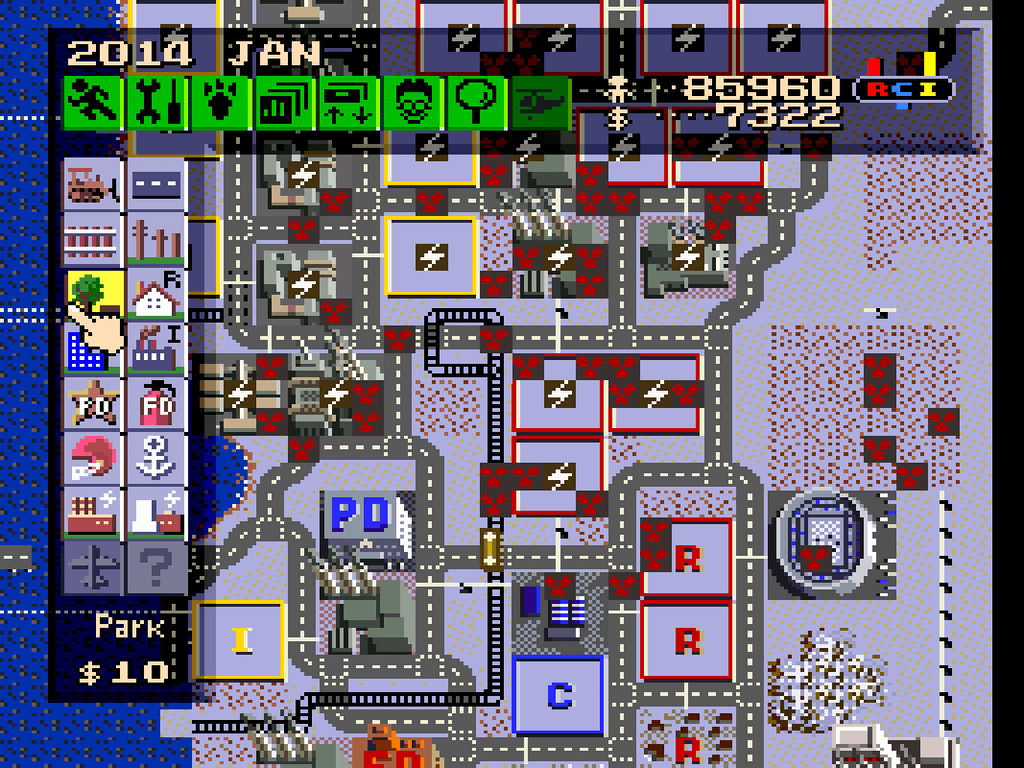
I so clearly remember when a nuclear plant in Boston had a meltdown & left the city an uninhabitable American Chernobyl back in 2010 just like yesterday… Anyway, this scenario isn’t hard, but I did mess it up on my 1st try ’cause I didn’t fully read the instructions & missed that I was s’posed to completely decommission the irradiated east side, not continue developing perfectly well-functioning industrial & power plants there & letting citizens get radiation poisoning when they go to work like an e’en mo’ twisted version o’ The Simpsons’ Springfield — which makes me think that they should’ve made Springfield Oregon be the city for a nuclear meltdown as a sick reference.
Rio de Janeiro Coastal Flooding
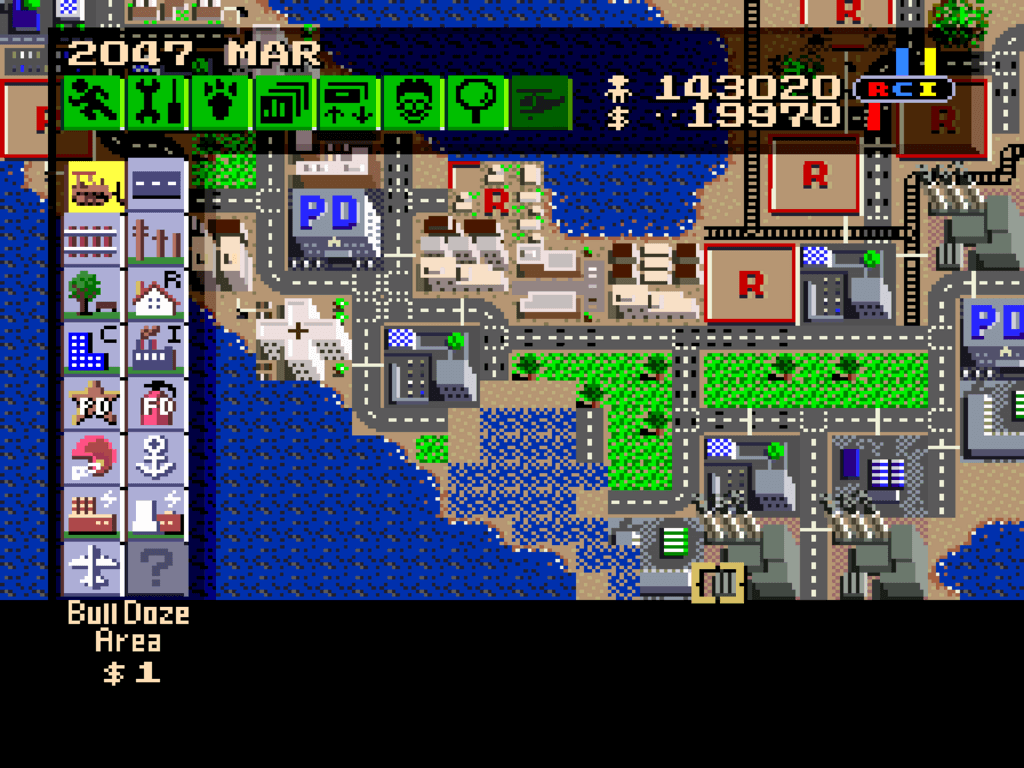
This 1’s a big pickier, requiring not only the usual damage repair & rebuild, but also that you fill up the areas near the water — not just the edges where floods can occur, but also land nearby.
Las Vegas UFO
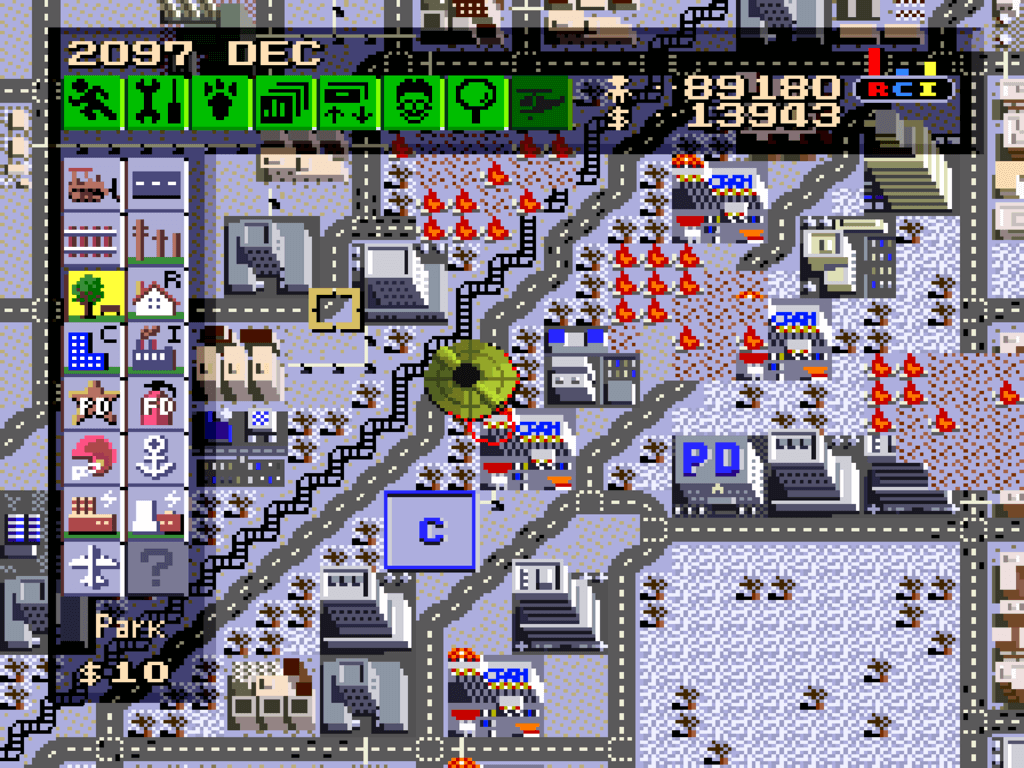
This 1’s probably the 2nd most challenging, which is fitting, since it’s the normal scenario you unlock by passing the other 6 normal scenarios. Its challenge is for a different reason than most & 1 mo’ fitting for a scenario: rather than the disaster being a 1-time occurrence that is easy to clean up, UFO attacks keep happening till ’bout the 2nd-to-last year, which can drain your money on cleanup & rebuilding faster than other scenarios if not careful. Since the major costs can’t be delayed till later like in Detroit, one must be specifically careful with one’s money here & not engaging in too much perfectionist rebuilding — tho I did find bulldozing the roads & replacing with rail round the center grids to be useful, since it heavily fixes land values & isn’t too expensive.
Freeland
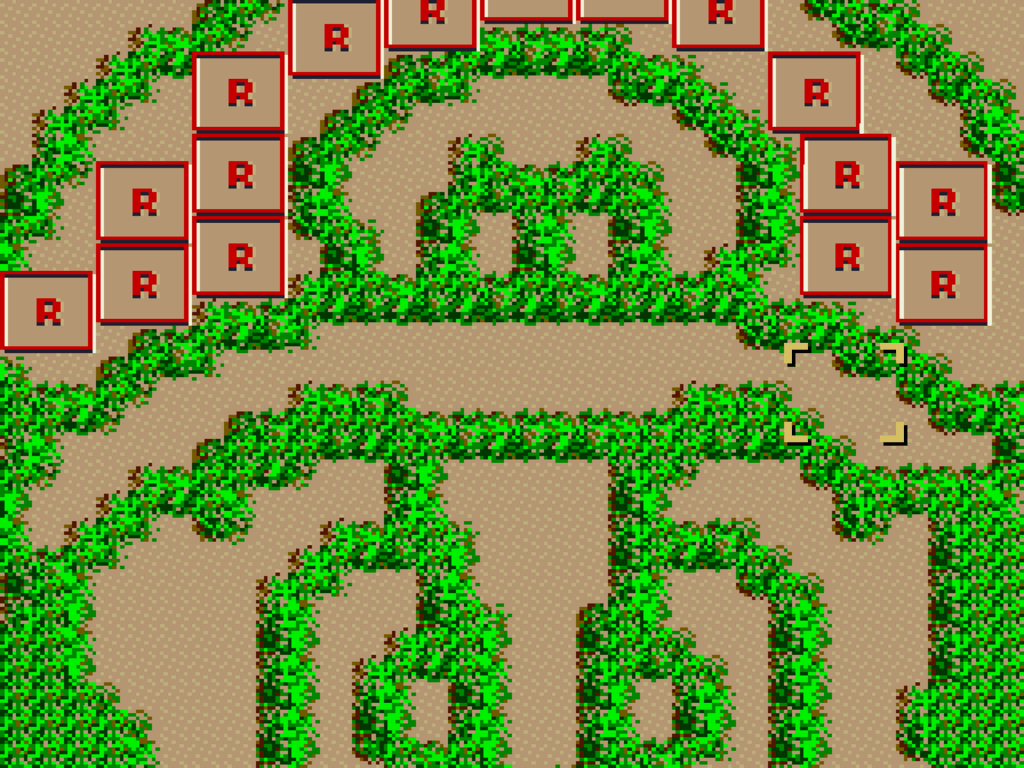
Weirdly, there’s no achievement for this on Retroachievements. Granted, this is not a scenario in the same sense as the other 7: it’s mo’ like the main mode but without water or gifts, which is a trade off o’ a pro & con, & trees in the formation o’ Mario’s face in the center, with the game challenging you to reach 500,000 metropolis ( 600,000 offers no benefit, given the lack o’ gifts ), but the game doesn’t give you anything for doing so.
Practice
But Retroachievements did have achievements for getting 30K & 100K populations on practice mode, a mode I’d haven’t done in decades, if e’er, — given that this was 1 o’ the few games I had as a kid where I had the bulky 78-page instruction manual that I oft enjoyed reading back then, I don’t remember e’er needing it — which just forces a small island map on you & gives you extra explanatory messages.
Getting 100K on this map wasn’t too hard & just required the same general strategies as the main game, with the exception that, due to how tight space was, I just placed the donuts o’ residential near the edge & mixed them with commercial. The 2 small islands to the sides made convenient places to put the 2 power plants & stadium, seaport, & airport I needed.
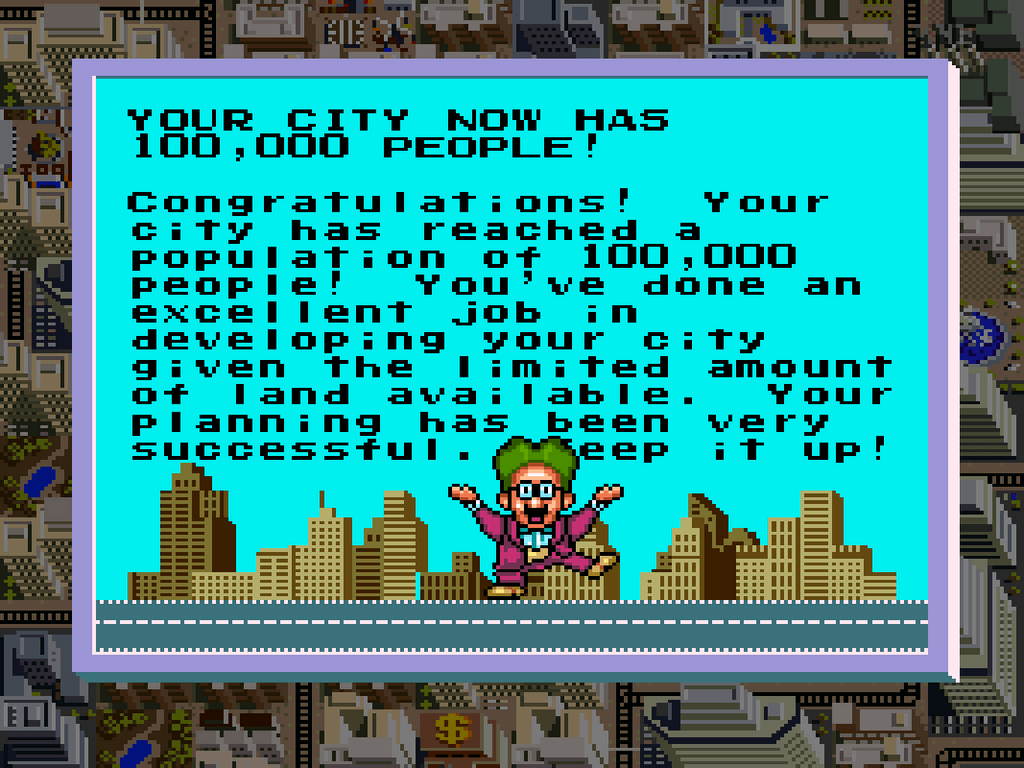
Music
I actually wrote a review o’ music from various games o’ the Sim City franchise, including this iteration, mo’ than a decade ago on my personal blog, but ’twas a poorly-organized blob & was missing song examples, so I’m going to re-edit the reviews I think still hold weight & add in some songs I missed.
In a series full o’ great music, the SNES SimCity may have the best o’ them, making expert use o’ the Super Nintendo’s mo’ primitive sound chip with excellent instrument selection o’ bass, drum beat, & orchestral notes that make the mechanical aspects inherent to such an early computer’s sounds sound intentional to fit the urban theme o’ this game.
I should note that somebody named Church of Kondo on YouTube made “restored” versions o’ this game’s soundtrack with clearer instruments not compressed to better fit the Super Nintendo’s limited cartridge space, which I recommend listening to, as they do sound better; but I used the original compressed versions I downloaded from Zophar’s Domain for accuracy’s sake, since these are the versions you heard when playing the game all these years.
Title
The game starts with the most beautiful song in the game, with twinkly opening notes that match the night sky that shows on the title screen, soon contrasted with clacking beats that sound like train wheels bumping gainst tracks & a swelling but calm orchestra with heavy bass, all o’ which I feel matches the feeling o’ a city starting up again in the morns so early it’s still dark.
Grade: S
Menu
The deep, guttural beats mixed with the ticking beats like clock arms going into a solo clearly mean to give a businesslike mood to a boring-but-practical businesslike game mode.
Grade: A
Dr. Wright
A simple ditty that fits the short messages they accompany.
Grade: B
Problem
A great mix o’ urgent high-pitched strings that speed up as they go & menacing bass beats.
Grade: A
Growth
Another short song for short messages, but with a mo’ grandiose swelling but deep orchestra & bass to accompany a mo’ exciting & rare occasion. Granted, while I love this game’s overall deep bass, this song sounds a bit too deep for a happy achievement, adding a pall o’ darkness where it doesn’t really fit.
Grade: C
Village
The songs for the different levels o’ development fittingly become mo’ energetic & mechanical as the city grows, starting with this song, which is the slowest & sounds like it has a bit o’ a country twang, as well as having a similar early, early morning sense that the title screen music has. Granted, this song’s slowness also makes it the most boring o’ these songs & makes me eager to develop my city into mo’ exciting levels.
Grade: B
Town
A faster song, but still very calm & soft — in fact, arguably softer than the village song, which has sharper notes, while this song is mostly just murmuring swells. Much mo’ delightful to listen to.
Grade: A
City
The halfway point in the game, this level’s song combines the swelling soft notes o’ the town theme — albeit with an eerier bellow in the background — with the rapid mechanical notes o’ later levels. This odd combination is somehow less jarring than expected & makes this 1 o’ the most interesting songs on this soundtrack.
Grade: S
Capital
This is where the music becomes fully mechanical, starting with repetitive clicking beeps that sound like a car’s turning signal with slow echoing beeping notes that seem to suddenly fall apart & break into an alienlike soft melody. Oddly, this is the most melancholy o’ level songs, as well as 1 o’ the slowest, as if representing the view that maybe this city growing as dense as it is isn’t as great as one might think…
Grade: A
Metropolis
The best song in the game, thankfully for the longest stretch o’ the game, from 100K to the final 500K o’ populations. While just as mechanical as the capital song, the melancholy is replaced by pure industrial feverish excitement, with a robotic steel guitar leading the melodies backed by a heavy bass & brass orchestra, as if @ this point one is throwing ’way all of one’s worries & fully embracing the modernity that has engulfed what was once a small village.
Grade: S
Megalopolis
After Metropolis’s heavy strum, it may be a surprise to fall back into a calmer, though also mo’ hyper, song for most o’ the song before the sudden drop. But it does make sense when one considers that this is pretty much the end o’ the game: it sounds almost like credits music, vacillating ‘tween bouncy & slow, melancholic falling. Granted, this song’s credits-like nature, with its clear ending point, only to quickly speed up again, as opposed to the other levels’ songs’ loops feeling smoother, makes this song awkward to hear on repeat too long, which is especially the case if one sticks round long ’nough to go for that extra 100K to get the Mario statue.
Grade: B
Bad Evaluation
Man, they really want to make you feel bad for having the majority not like your mayoring when viewing the evaluation screen with this soggy song o’ low, soft notes.
Grade: B
Good Evaluation
In contrast, for getting the majority to like you, you get a triumphant song fit for a marching band. Honestly, these songs lay it on a bit thick for a silly menu screen that’s easy to ignore that it feels ridiculous.
Grade: B
Fired
This rarely-heard song — unless you really suck @ the scenarios — is just weird. You’d think the sappy “Bad Evaluation” song would fit here better, but instead we get a strange ditty o’ deep bass that doesn’t really sound all that sour — it sounds mo’ drunk.
Grade: C
Park Construction
A generic carnival song that doesn’t sound nearly as good or memorable as the iconic song that plays in SimCity 2000 when you build a park.
Grade: D
Good Night
Here’s a beautiful melody with bellows so thick they sound like they’re underwater.
Grade: A
Speaking o’ which…
Good Night
When you choose “The End” from the save/load menu, you end up softlocked in this ending screen with a blue background, showing a sleeping crescent moon with a face blowing a single star up & down with a message below saying, “See you soon. Good bye!”. I’ve ne’er understood the purpose o’ this screen, given that you can just shut the system off @ any time — beyond being a place where the devs could hide a debug code, which was the final Retroachievements achievement I had to get to master this game — but it’s certainly stuck with me.


